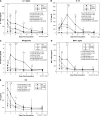Variation in colonization, ADP-ribosylating and vacuolating cytotoxin, and pulmonary disease severity among mycoplasma pneumoniae strains
- PMID: 20508214
- PMCID: PMC2949405
- DOI: 10.1164/rccm.201001-0080OC
Variation in colonization, ADP-ribosylating and vacuolating cytotoxin, and pulmonary disease severity among mycoplasma pneumoniae strains
Abstract
Rationale: Mycoplasma pneumoniae was recently discovered to produce an ADP-ribosylating and vacuolating cytotoxin, designated CARDS toxin, which is hypothesized to be a primary pathogenic mechanism responsible for M. pneumoniae-induced pulmonary inflammation. It is unknown if cytotoxin production varies with M. pneumoniae strain or if variation in cytotoxin production affects pulmonary disease severity.
Objectives: To examine the production of CARDS toxin by various strains of M. pneumoniae and compare the disease manifestations elicited by these strains in an experimental model of M. pneumoniae respiratory infection.
Methods: BALB/c mice were inoculated once intranasally with SP4 broth (negative control) or three different M. pneumoniae strains: M129-B7, M129-B9, or S1. Mice were assessed at 1, 2, 4, 7, 10, and 14 days after inoculation. Outcome variables included comparisons among M. pneumoniae strains relative to bronchoalveolar lavage (BAL) M. pneumoniae quantitative culture, CARDS toxin-based PCR, and CARDS toxin protein determinations, as well as cytokine and chemokine concentrations. Graded lung histopathologic score (HPS) was also assessed.
Measurements and main results: CARDS toxin concentrations were significantly increased in mice inoculated with strain S1 compared with mice inoculated with M129-B7 or M129-B9 strains. Quantitative M. pneumoniae culture and polymerase chain reaction were also significantly greater in mice infected with S1 strain compared with the other two strains, as were lung HPS and concentrations of IFN-γ, IL-12, IL-1α, macrophage inflammatory protein-1α, and keratinocyte-derived chemokine. In addition, a significant positive correlation was found between CARDS toxin concentration and lung HPS.
Conclusions: CARDS toxin concentrations in BAL are directly linked to the ability of specific M. pneumoniae strains to colonize, replicate, and persist, and elicit lung histopathology. This variation among strains may predict the range in severity of pulmonary disease observed among patients.
Figures








References
-
- Esposito S, Cavagna R, Bosis S, Droghetti R, Faelli N, Principi N. Emerging role of Mycoplasma pneumoniae in children with acute pharyngitis. Eur J Clin Microbiol Infect Dis 2002;21:607–610. - PubMed
-
- Block S, Hedrick J, Hammerschlag MR, Cassell GH, Craft JC. Mycoplasma pneumoniae and Chlamydia pneumoniae in pediatric community-acquired pneumonia: comparative efficacy and safety of clarithromycin vs. erythromycin ethylsuccinate. Pediatr Infect Dis J 1995;14:471–477. - PubMed
-
- Michelow IC, Olsen K, Lozano J, Rollins NK, Duffy LB, Ziegler T, Kauppila J, Leinonen M, McCracken GH Jr. Epidemiology and clinical characteristics of community-acquired pneumonia in hospitalized children. Pediatrics 2004;113:701–707. - PubMed
-
- Wubbel L, Muniz L, Ahmed A, Trujillo M, Carubelli C, McCoig C, Abramo T, Leinonen M, McCracken GH Jr. Etiology and treatment of community-acquired pneumonia in ambulatory children. Pediatr Infect Dis J 1999;18:98–104. - PubMed
Publication types
MeSH terms
Substances
Grants and funding
LinkOut - more resources
Full Text Sources
Other Literature Sources
Medical
Molecular Biology Databases

